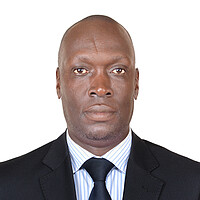Lions, leopards, and ... lessons? How safari tourism boosts rural education.
Loading...
| Kikarara, Uganda
It’s not a question of if the old mud and wattle building will give way, but when.
From outside, the ramshackle structure appears abandoned. The slumped walls and rusted tin roof of the Nyakalembe Community School bear no resemblance to the modern schools found in Uganda’s capital.
“It will collapse on us anytime,” says Prize Otaremwa.
Why We Wrote This
Government schemes don’t always live up to their promises. In Uganda, a program designed to divert tourist dollars into rural communities has been criticized as ineffective. But a new focus is restoring hope.
The headmaster prays that doesn’t happen before construction workers can complete a new brick building – or at the very least that the collapse comes at night when the children are at home safe in their beds.
In this part of Uganda, brick walls, a cement screed floor, and a corrugated iron slab roof represent forward momentum. But funds for such projects can be hard to come by. After decades of civil war, this East African nation has scrambled to rebuild its cities. But rural areas have largely been left behind.
Here in Kikarara, Mr. Otaremwa sees hope for a new future for his students and his school, thanks to a recent push to invest funds garnered from safari tourism in local schools.
The Uganda Wildlife Authority’s revenue-sharing program is in many ways indicative of the changes that have rippled through this region. In the past 30 years, the country has worked to establish a new economy that leverages its wealth of natural resources. That shift has brought the promise of a prosperous future for the nation as a whole.
But many Ugandans, particularly those in rural communities, have felt that this progress has come at their expense. The demarcation of national parks has ushered in a new era of conservation-minded policies. For some, it has seemed as if the well-being of the parks’ animals has taken precedence over the livelihoods of their human neighbors.
Locals have had to change their way of life, as they no longer are allowed to hunt for food or forage for fuel within the parks. And while visitor fees have bolstered government coffers and funded urban development, rural residents have watched helplessly as now-protected lions and elephants have devoured livestock and trampled kitchen gardens.
The UWA’s revenue sharing program is meant to shift that equation by distributing 20 percent of park entrance fees to local communities. In the past, the program has drawn criticism for failing to meet that promise. But a recent emphasis on investment in schools has renewed hope for many residents.
When Kikarara Parish received 40 million Ugandan shillings (about $12,000) in 2015, a new school for the village of Nyakalembe seemed like the perfect project. Investment in education, after all, is an investment in the nation’s future.
“Because of the low levels of education, investing in a school in the middle of the parish was the right thing,” says Michael Tukamusherura, who was chair of the parish at the time.
Otaremwa is hopeful that a better school will bring more families to the community, prompting the government to increase investment in other facilities.
Uganda’s national parks are home to some of Africa’s most iconic safari animals: elephants, rhinoceroses, buffalo, leopards, and lions. The Queen Elizabeth National Park near Kikarara is home to one of just two populations of tree-climbing lions in the world.
These animals have been a major draw for tourists. Some 325,000 visitors flocked to the parks in 2018, about half of whom were international tourists. Entrance to most Ugandan national parks costs $40 for foreign nonresidents, $30 for foreign residents with a work visa, and about $5 for East African nationals. Visitors to the Bwindi Impenetrable National Park pay up to $600 to track mountain gorillas.
The UWA began setting aside 20 percent of fees from Bwindi in 1993. By 1996 the program had spread to include all of Uganda’s national parks and was enshrined into law with the Uganda Wildlife Act. In the past five years, 13 billion shillings ($3.5 million) has been diverted to local communities, according to UWA spokesman Bashir Hangi.
Park visitors who spoke with the Monitor expressed support for the program. One suggested that communities should receive an even larger share of the proceeds. Another wondered if the funds were being used appropriately.
“Does it reach those who most need it?” asks A.J. van Bodegom, a Dutch tourist visiting Murchison Falls National Park in northern Uganda.
How those funds get distributed has been a point of contention. The money is given to district officials who consult with parish committees to decide which projects to invest in.
One project that has been dogged by criticism has been the distribution of goats. Through this scheme, which gained popularity beginning in 2007, villages typically received about nine goats per year. With between 100 and 150 households per village, that meant only a handful of families would see any benefit in a given year. One study examining the efficacy of the program found that it took 11 to 17 years for each household to receive a goat.
The recent emphasis on investment in schools (as well as health centers) has helped to bolster the image of the program as a benefit for whole communities. Still, many locals say they should be included more in the process.
In Kikarara, Otaremwa, the headmaster, says he has not been involved in the planning or development of the new school.
He can’t say when the building might be finished, he says, because he doesn’t know. He can only hope that it happens in time.






